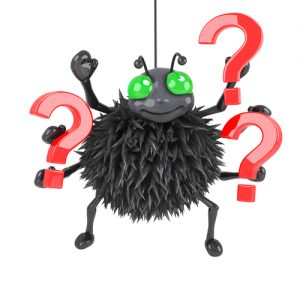I have sticky black dots all over my siding. Are they insects?
By Chris Williams on December 28, 2011.
No, but I wondered the same thing once. For several years now, I’ve seen this stuff on homes. Because of it’s sticky tar-like appearance, I first thought that it might be soot or residue from the home’s heating system (but it didn’t have an oily odor) Then I thought maybe it’s spider droppings, but gave up on that idea because I’ve seen some homes literally covered with it without many spiders. Finally, I’m thinking it must be some type of plant feeding scale insect, but why then would they settle on the siding? Then, a few seasons ago I was treating a client’s nicely landscaped home when she excitedly told me she’d finally found out what a certain type of fungus in her planting beds was. I replied, “You mean the one that looks like dog vomit?” No, she said, “We have that one too, but this one is called ‘shot gun’ fungus, and it’s making a mess all over one side of the house.” (This is further proof by the way that you can Google just about anything!)
 As it turns out, Sphaerolobolus stellatus aka, ‘artillery fungus’ is the culprit responsible for all that mess (which are it’s spores) on the siding, garden path stones, paved walkways, and maybe even on your Rhododendrons. It thrives in old mulch (when mulch looks less like wood shavings and more like soil!) and is capable of launching spores to impressive heights. I’ve seen them stuck up on house siding at nearly twenty feet! Unfortunately, they do not wash off easily on vinyl or natural sided homes. For now, the best management practice appears to be to maintain a fresh layer of natural mulch covering over the existing material to cut down on the amount of spores ‘launching’. Stone or synthetic materials in foundation plantings may also be an option. So now you know what it is, and to find out more about this unusual organism, you may want to visit this link (http://www.hort.uconn.edu/ipm/greenhs/htms/blkspothouses.htm)
As it turns out, Sphaerolobolus stellatus aka, ‘artillery fungus’ is the culprit responsible for all that mess (which are it’s spores) on the siding, garden path stones, paved walkways, and maybe even on your Rhododendrons. It thrives in old mulch (when mulch looks less like wood shavings and more like soil!) and is capable of launching spores to impressive heights. I’ve seen them stuck up on house siding at nearly twenty feet! Unfortunately, they do not wash off easily on vinyl or natural sided homes. For now, the best management practice appears to be to maintain a fresh layer of natural mulch covering over the existing material to cut down on the amount of spores ‘launching’. Stone or synthetic materials in foundation plantings may also be an option. So now you know what it is, and to find out more about this unusual organism, you may want to visit this link (http://www.hort.uconn.edu/ipm/greenhs/htms/blkspothouses.htm)